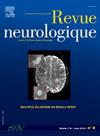视神经炎血浆置换的使用标准:法国专家中心的实践回顾。
IF 2.3
4区 医学
Q2 CLINICAL NEUROLOGY
引用次数: 0
摘要
简介:一些患者在视神经炎发作后仍然严重残疾。一些研究表明,在皮质类固醇治疗后视力恢复不理想的情况下,血浆置换(PE)可以改善视力预后。然而,没有明确的眼科标准做体育,实践差异很大。本研究的目的是更好地定义使用PE的理由。材料和方法:我们调查了法国专家中心PE的现实适应症。根据问卷调查结果和现有文献,我们进一步提供了指导方针,旨在规范视神经炎治疗中PE的使用。结果:20家专家中心完成问卷调查。在研究期间,他们合计占法国PE治疗患者的90%。使用PE的主要标准如下:尽管使用皮质类固醇,但视力严重受损(平均视力)结论:本研究为法国视神经炎治疗中心的PE现实适应症提供了有见地的信息。基于我们的发现和文献中的可用数据,我们提供了视神经炎管理的决策算法。本文章由计算机程序翻译,如有差异,请以英文原文为准。
Criteria for the use of plasmapheresesis in optic neuritis: A practice review from French expert centers
Introduction
Some patients remain severely disabled after an episode of optic neuritis. Several studies have shown that plasmapheresis (PE) can improve visual prognosis in the absence of satisfactory recovery after corticosteroids. However, there is no clear ophthalmological criterion for doing PE, and practices vary widely. The objective of the present study was to better define the rationales for use of PE.
Material and methods
We investigated the real-life indications for PE in French expert centers. Based on the responses to a questionnaire and the current literature, we further provided guidelines aiming to standardize the use of PE for the management of optic neuritis.
Results
Twenty expert centers completed the questionnaire. Together, they accounted for 90% of patients treated by PE in France during the study period. The main criteria for using PE were as follows: severely impaired visual acuity despite corticosteroids (mean visual acuity < 0.6 logMAR or 20/80), high suspicion for neuromyelitis optica spectrum disorder, bilateral optic neuritis, or a profound visual field alteration.
Conclusion
This study provides insightful information about the real-life indications for PE in French centers for the treatment of optic neuritis. Based on our findings and the available data in the literature, we provide a decision-making algorithm for the management of optic neuritis.
求助全文
通过发布文献求助,成功后即可免费获取论文全文。
去求助
来源期刊

Revue neurologique
医学-临床神经学
CiteScore
4.80
自引率
0.00%
发文量
598
审稿时长
55 days
期刊介绍:
The first issue of the Revue Neurologique, featuring an original article by Jean-Martin Charcot, was published on February 28th, 1893. Six years later, the French Society of Neurology (SFN) adopted this journal as its official publication in the year of its foundation, 1899.
The Revue Neurologique was published throughout the 20th century without interruption and is indexed in all international databases (including Current Contents, Pubmed, Scopus). Ten annual issues provide original peer-reviewed clinical and research articles, and review articles giving up-to-date insights in all areas of neurology. The Revue Neurologique also publishes guidelines and recommendations.
The Revue Neurologique publishes original articles, brief reports, general reviews, editorials, and letters to the editor as well as correspondence concerning articles previously published in the journal in the correspondence column.
 求助内容:
求助内容: 应助结果提醒方式:
应助结果提醒方式:


